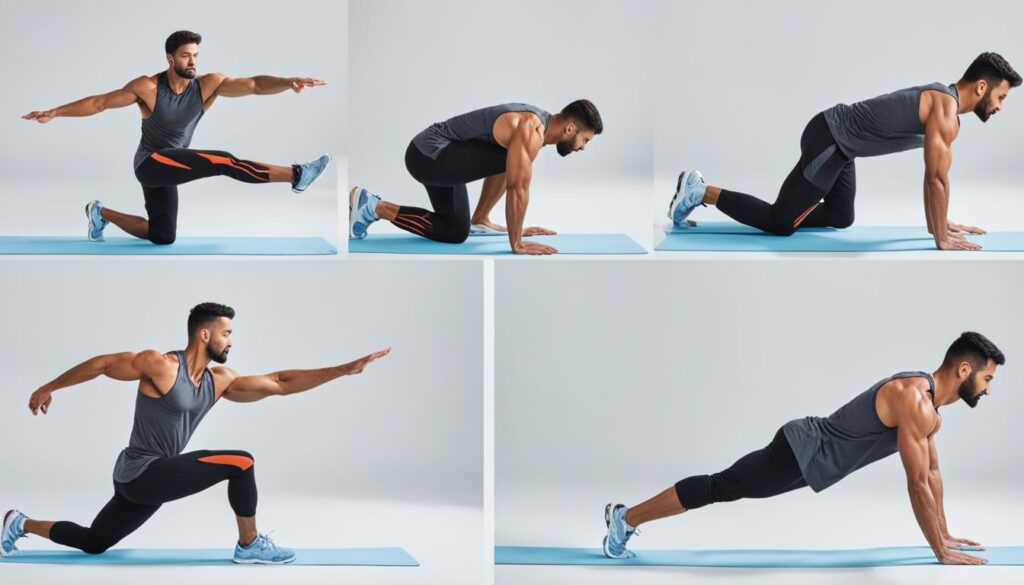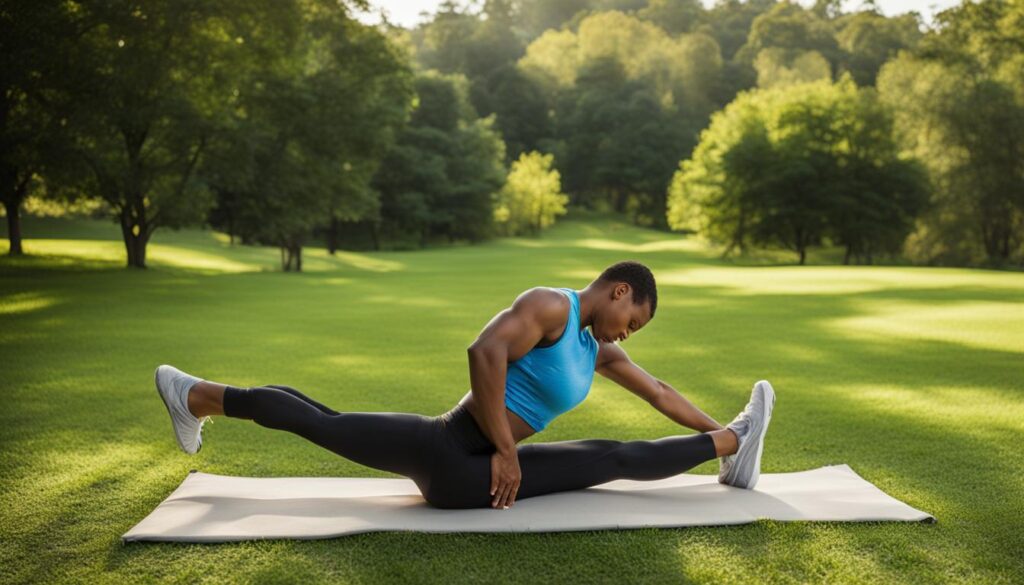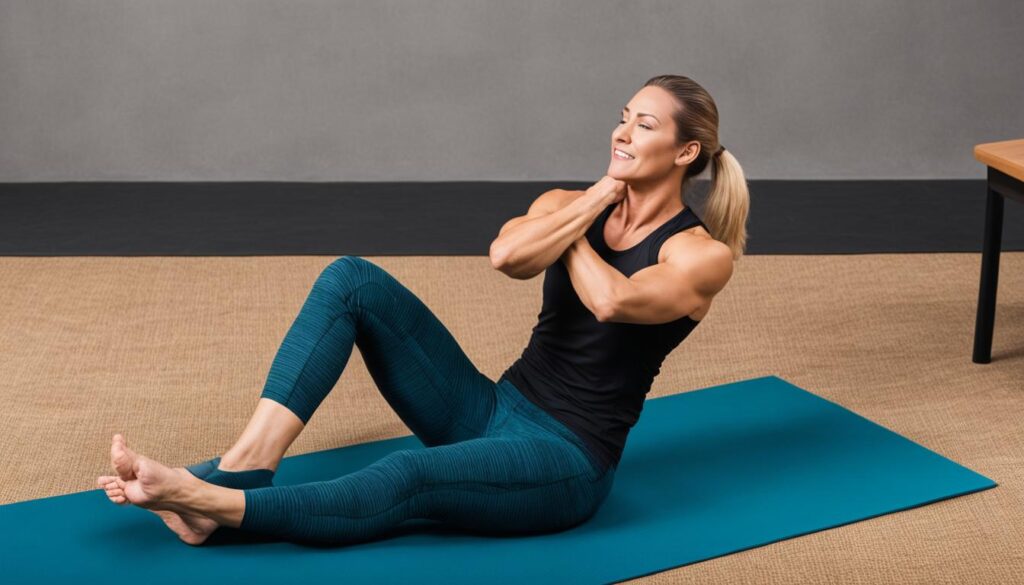Leg cramps can be a painful and uncomfortable experience, causing disruption to daily activities and sleep. However, there are effective stretches that can provide immediate relief from leg cramps. These stretches target the muscles and nerves in the legs, promoting relaxation and relieving tension. By incorporating these stretches into your routine, you can prevent leg cramps and improve flexibility.
Key Takeaways:
- Incorporating stretches into your routine can provide relief from leg cramps.
- Stretches target the muscles and nerves in the legs, promoting relaxation and relieving tension.
- Regular stretching can help prevent leg cramps and improve flexibility.
- Leg cramps can be managed and prevented through proper self-care measures and stretches.
- If leg cramps persist or become severe, it is important to seek medical attention for further evaluation and treatment.
Why Do Leg Cramps Occur?
Leg cramps can be a bothersome and painful experience, but understanding the causes behind them can help in managing and preventing their occurrence. Leg cramps can happen due to several factors, such as dehydration, muscle fatigue, electrolyte imbalances, and poor circulation.
Dehydration: One of the main culprits behind leg cramps is dehydration. When the body is dehydrated, it can lead to an imbalance of electrolytes like potassium, magnesium, and calcium, which are essential for proper muscle function. This disruption in electrolyte balance can trigger muscle cramps in the legs.
Muscle fatigue: Overuse or prolonged periods of inactivity can cause muscle fatigue, which can contribute to leg cramps. When muscles are fatigued, they are more prone to involuntary contractions and spasms, leading to cramps in the legs.
Electrolyte imbalances: As mentioned earlier, imbalances in electrolytes can be a trigger for leg cramps. These imbalances can occur not only due to dehydration but also as a result of certain medical conditions or inadequate intake of electrolyte-rich foods.
Poor circulation: Inadequate blood flow to the legs can also be a factor in the occurrence of leg cramps. Poor circulation can be caused by various conditions like peripheral artery disease or other underlying medical conditions.
Identifying the underlying cause of leg cramps is crucial for effectively managing and preventing them. It is essential to stay hydrated, maintain a healthy diet, and incorporate regular exercise and stretching into your routine to minimize the risk of leg cramps.
Common Causes of Leg Cramps:
- Dehydration
- Muscle fatigue
- Electrolyte imbalances
- Poor circulation
Effective Stretches for Leg Cramp Relief
When it comes to finding relief from leg cramps, incorporating effective stretches into your daily routine can make a significant difference. By targeting the muscles in your legs and promoting relaxation, these stretches can provide the much-needed relief you seek. Let’s explore some of the best stretching exercises for leg cramp relief.
1. Full Body Stretch
The Full Body Stretch is a simple yet effective exercise that focuses on relieving tension in your legs. To perform this stretch:
- Place one leg up on a stool or step.
- Glide your body forward, bending at the knee, and aligning your raised leg with your body.
- Feel a gentle stretch in your thigh and calf muscles.
- Hold the position for 15-30 seconds.
- Repeat with the other leg.
2. Hamstring Stretch
The Hamstring Stretch helps to alleviate tightness and cramping in the back of your legs. Here’s how you can do it:
- Keep one knee straight and place the heel of your other foot on a stool or step.
- Lean your chest forward, maintaining a straight back, until you feel a stretch in your hamstring.
- Hold the position for 15-30 seconds.
- Switch legs and repeat.
3. Calf Stretch
The Calf Stretch targets the calf muscles, which are often prone to cramping. Follow these steps to perform the stretch:
- Stand facing a wall, with your feet hip-width apart.
- Bend one knee towards the wall, keeping the other leg straight.
- Lean your body forward, pressing your heel into the ground, until you feel a stretch in your calf.
- Hold the position for 15-30 seconds.
- Switch legs and repeat.
These leg cramp relief exercises can be performed throughout the day whenever you experience discomfort or stiffness. Remember to breathe deeply and listen to your body to avoid overstretching. By incorporating these stretches into your routine, you can actively prevent leg cramps and enjoy improved flexibility.

Tips for Preventing Leg Cramps
In addition to incorporating stretches into your routine, there are several tips for preventing leg cramps. Staying properly hydrated is essential, as dehydration can contribute to muscle cramps. Make sure to drink plenty of water throughout the day, especially during and after physical activity.
Maintaining a balanced diet that includes foods rich in potassium, magnesium, and calcium can also help prevent leg cramps. These minerals are important for muscle function and can help reduce the occurrence of cramps. Some examples of such foods include:
| Potassium-rich foods | Magnesium-rich foods | Calcium-rich foods |
|---|---|---|
| Bananas | Spinach | Milk |
| Oranges | Almonds | Cheese |
| Potatoes | Pumpkin seeds | Yogurt |
Regular exercise and stretching can improve muscle strength and flexibility, reducing the risk of cramps. Engaging in activities such as walking, cycling, or swimming can help keep your legs healthy and reduce the likelihood of cramps. Incorporate exercises that target the leg muscles, such as calf raises or leg extensions, into your routine for added benefits.
Avoiding prolonged periods of inactivity and maintaining good circulation in the legs can also help prevent leg cramps. If you have a sedentary job, make sure to take breaks to stretch your legs and move around. Elevating your legs when sitting or lying down can also promote healthy blood flow and prevent cramps.

When to Seek Medical Attention
In most cases, leg cramps can be managed with self-care measures and stretches. However, if leg cramps persist or become more frequent, it may be necessary to seek medical attention. A healthcare provider can provide a personalized approach to finding relief and may recommend additional treatment options.
If your leg cramps are severe, not improving with self-care, or accompanied by other concerning symptoms, it is important to consult with a healthcare provider. They can evaluate your symptoms, perform any necessary tests, and determine the best course of action for treatment.
“If leg cramps are interfering with your daily life or sleep, a healthcare provider may prescribe medication to relax muscles or promote better sleep. Seeking medical attention can help you find the most effective leg cramp remedies for your specific situation.”
Article Highlight
- In most cases, leg cramps can be treated with self-care measures and stretches.
- If leg cramps persist or become more frequent, consult a healthcare provider.
- Medical attention can provide personalized treatment options.
- Severe cramps, lack of improvement, and accompanying symptoms warrant medical consultation.
By seeking timely medical attention, you can find appropriate leg cramp treatments and remedies to alleviate the discomfort and improve your quality of life.
Conclusion
Leg cramps can be a common and painful experience, but incorporating stretches into your routine can provide relief and prevent them from occurring. By targeting the muscles and nerves in the legs, these stretches promote relaxation and improve flexibility.
In addition to stretches, staying hydrated, maintaining a balanced diet, and regular exercise can help prevent leg cramps. Adequate hydration is essential to ensure proper muscle function, while a balanced diet rich in potassium, magnesium, and calcium can support muscle health.
If leg cramps persist or become more severe, it is important to seek medical attention for further evaluation and treatment. A healthcare provider can provide personalized recommendations and may suggest additional techniques or medications to alleviate leg cramps.
By practicing proper care and prevention techniques, you can find relief from leg cramps and improve your overall leg health. Make sure to incorporate stretches, stay hydrated, follow a balanced diet, and engage in regular exercise to minimize the occurrence of leg cramps and enhance your well-being.
FAQ
What are the best stretches for leg cramp relief?
Some effective stretches for leg cramp relief include the Full Body Stretch, Hamstring Stretch, and Calf Stretch. These stretches target the muscles in the legs and promote relaxation.
Why do leg cramps occur?
Leg cramps can occur due to various reasons such as dehydration, muscle fatigue, electrolyte imbalances, poor circulation, or underlying medical conditions like diabetes or nerve damage.
What are effective stretches for leg cramp relief?
Effective stretches for leg cramp relief include the Full Body Stretch, Hamstring Stretch, and Calf Stretch. These stretches help relax the muscles and relieve tension in the legs.
What are some tips for preventing leg cramps?
Staying hydrated, maintaining a balanced diet rich in potassium, magnesium, and calcium, regular exercise, and stretching can help prevent leg cramps. Avoiding prolonged periods of inactivity and improving circulation in the legs can also be beneficial.
When should I seek medical attention for leg cramps?
If leg cramps persist, become more severe, or are accompanied by other concerning symptoms, it is important to seek medical attention. A healthcare provider can provide a personalized approach to finding relief and may recommend additional treatment options.
Conclusion
Leg cramps can be managed with self-care measures and stretches. By incorporating effective stretches into your routine, staying hydrated, and maintaining a healthy lifestyle, you can find relief from leg cramps and improve your overall leg health.





